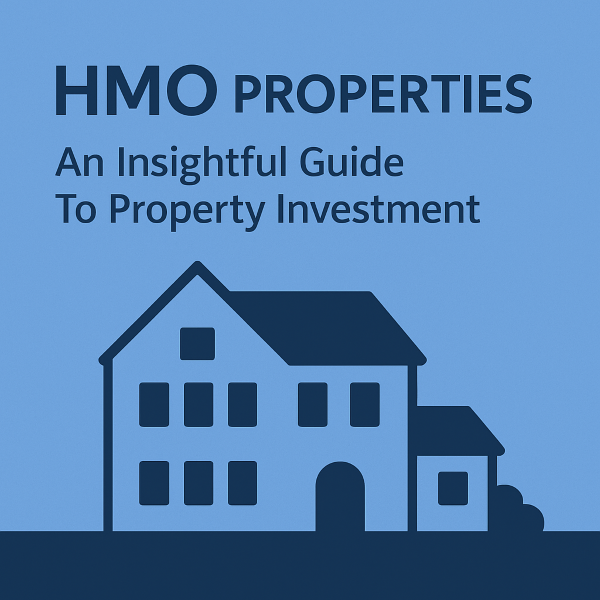HMO Properties – What Advisers and Investors Need to Know | HMO stands for House in Multiple Occupation, a residential property rented out by three or more unrelated individuals who share facilities like kitchens or bathrooms. For example, three professionals sharing a house would qualify as an HMO, whereas a family of three living together would not.
What Is an HMO Property?
An HMO property (House in Multiple Occupation) is a type of residential housing where three or more unrelated tenants from different households share common facilities such as kitchens, bathrooms, or toilets. These properties are common in student housing, house shares, and some converted residential buildings.
Unlike standard buy-to-let properties, HMOs are subject to stricter regulations governing safety, space, and amenities. Most landlords must apply for a specific HMO licence from the local authority and failing to do so can result in significant penalties. If you’re advising clients on rental investment strategies, it’s crucial to understand the compliance responsibilities involved.
For more information, visit our HMO Property Guide page.
HMO vs Buy-to-Let: Which Investment Strategy Suits You? |
|
|---|---|
| Deciding between a House in Multiple Occupation (HMO) and a Buy-to-Let (BTL) depends on your investment objectives, time commitment, and appetite for regulatory complexity. While HMOs can deliver higher returns, they require more active management and licensing. In contrast, BTLs offer a lower-risk, more straightforward path ideal for hands-off investors. Learn more about structuring your property strategy with our property investment insights. | |
| What Is an HMO? | |
| An HMO is a rental property occupied by three or more unrelated individuals who share communal spaces such as bathrooms or kitchens. Popular in university cities and urban hubs, HMOs are especially attractive to students and young professionals. Read how mortgage networks support specialist landlords. | |
| HMO Advantages | HMO Challenges |
| ✔️ Higher Rental Yields: Individual room lettings can generate yields of 8–12%, significantly outperforming single tenancy BTLs. | ⚠️ Complex Management: Managing multiple contracts, tenant queries, and maintenance demands time or a letting agent. |
| ✔️ Diversified Income: Rent continues from other tenants even if one room becomes vacant. | ⚠️ Strict Licensing & Compliance: Local authorities often require specific HMO licenses, plus adherence to room size and fire safety rules. |
| ✔️ Strong Demand: HMOs remain popular near universities and job hubs, ensuring steady occupancy. | ⚠️ Higher Operating Costs: Landlords usually cover utilities, council tax, and maintenance, impacting net profit. |
| ✔️ Capital Growth Potential: Converting a single-let into an HMO can significantly boost property value. | ⚠️ Financing Barriers: HMO mortgages are niche, require larger down payments, and carry higher rates. See more on specialist mortgage networks. |
| What Is a Traditional Buy-to-Let? | |
| A traditional Buy-to-Let involves letting an entire property to a single household. It’s ideal for investors seeking predictable income with minimal day-to-day involvement. For guidance on securing the right support, explore our adviser support services. | |
| BTL Advantages | BTL Challenges |
| ✔️ Low Maintenance: One tenancy agreement and fewer tenants reduce management complexity. | ⚠️ Lower Yields: Typical returns average 4–6%, less than multi-let HMOs. |
| ✔️ Stable Tenants: Families and couples often stay longer, reducing turnover and void periods. | ⚠️ Income Risk During Voids: If your tenant leaves, the entire rent stops until re-let. |
| ✔️ Accessible Mortgages: More lenders, better rates, and simplified lending criteria. | ⚠️ Market Sensitivity: Lower profit margins mean less buffer during interest rate rises or economic downturns. |
| ✔️ Tenant Manages Bills: Most BTL tenants pay their own utilities and council tax, easing admin load for landlords. | ⚠️ Limited Value Add: Single-let properties may offer limited scope to increase yield or capital value. |
| Which Strategy Is Right for You? | |
| Choose an HMO investment if you’re experienced, want to maximise cash flow, and are prepared to manage it yourself or to hire a specialist agent.
Opt for a Buy-to-Let if you’re new to property, prefer simplicity, or want a stable, long-term income stream without navigating HMO compliance. |
|
Is Investing in HMOs Still Worth It?
With increasing regulation and rising operational demands, many property investors are asking: Is HMO investment still worth it in today’s market? The answer depends on your investment goals, risk tolerance, and level of involvement.
For those seeking higher rental yields and willing to manage compliance requirements, HMO properties can still deliver strong returns. In high-demand urban areas where shared housing is essential, such as student towns or cities with a transient workforce, HMOs continue to offer consistent rental income and reduced void periods.
However, profitability is heavily influenced by local market conditions and licensing regulations. Conduct detailed research into tenant demand, council policies, and housing supply in your chosen location before proceeding. If you’re unsure how to approach market analysis, our Adviser Support Services can guide your due diligence.
For hands-off investors or those without the resources to actively manage tenant turnover and maintenance, a traditional buy-to-let may be more suitable. If you’re exploring different paths to property income, our insights into mortgage networks for advisers and specialist landlord support provide valuable perspectives on balancing yield with manageability.
What Makes HMOs a Unique Rental Strategy?
Houses in Multiple Occupation (HMOs) stand out from traditional rental models by offering a shared living experience tailored to diverse tenant needs. Unlike standard single-let properties, HMOs accommodate multiple individuals or households under one roof, sharing communal areas like kitchens, lounges, and bathrooms.
This co-living environment promotes social interaction and often fosters a strong sense of community, which is increasingly valued by tenants, particularly students, young professionals, and those seeking affordable housing.
📌 Curious about how HMOs differ from co-living setups? Explore our full breakdown in Co-Living vs. HMO: Key Differences.
Why Tenants Are Drawn to HMOs
-
Community Living – The shared lifestyle encourages friendships and social support, which can lead to longer tenancies.
-
Cost Efficiency – Shared utility bills and facilities reduce each tenant’s financial burden, making HMOs ideal for budget-conscious renters.
-
Flexible Tenancy Terms – Many HMOs offer rolling contracts or short-term agreements, perfect for those with transient lifestyles or uncertain work locations.
-
Modern Support Tools – Landlords and property managers are increasingly using AI-driven systems for tenant communication, rent collection, and utility tracking, creating a smoother experience for all.
Adviser Tip: Positioning HMOs in Your Portfolio
If you advise landlords or property investors, highlighting the high-yield potential and low vacancy risk of HMOs can be a compelling strategy. For wider support on sourcing deals, regulatory guidance, or integrating HMO opportunities into your services, visit our page on Adviser Support Services.
Who Typically Lives in an HMO?
In today’s economic climate marked by rising rents and cost-of-living pressures, shared accommodation, such as Houses in Multiple Occupation (HMOs), is becoming increasingly attractive. While anyone can reside in an HMO, these properties tend to appeal to specific demographics seeking affordability, flexibility, or social engagement.
Common HMO Tenant Profiles
Most HMO residents fall into one of the following categories:
-
Young professionals are seeking affordable, well-located housing while focusing on their careers.
-
Contractors or short-term workers in need of temporary residence during project-based work.
-
Students, particularly in university towns, are drawn to budget-friendly, communal living options.
-
Lower-income individuals who value shared costs and accessible urban locations.
It’s important to note that lower income does not equate to high risk. In fact, young professionals remain the most common and stable tenant type in HMOs. They typically prefer not to invest in single-occupancy units, opting instead for modern, cost-effective shared living.
For more on supporting these client profiles through smart lending options, see our Mortgage Network for Advisers page.
Grouping Matters in Shared Housing
When managing an HMO, grouping similar tenant types is considered best practice. For instance, in a four-bed HMO with three students, it’s not advisable to place a working professional or an older contractor in the remaining room. Aligning residents by lifestyle, routine, and expectation helps reduce tenant turnover and conflict.
Can a Landlord Live in an HMO?
Yes. Owner-occupiers may reside in their own HMOs, provided they comply with all legal obligations applicable to HMO landlords. This arrangement is increasingly popular among homeowners with unused space who want to generate additional income without sacrificing compliance or property standards.
Learn more about your legal responsibilities and tenant support strategies in our Adviser Support Services section.
Do I need an Expert Mortgage Broker?
Absolutely! Partnering with an experienced mortgage broker can be a critical step in building long-term financial and mortgage resilience, especially when navigating complex property investments.
Before committing to an investment strategy, speak with a qualified adviser, such as those listed in the Connect Mortgage Adviser Directory. Their team will guide you through the unique mortgage eligibility criteria, lender requirements, and legal considerations for various property types, whether you’re investing in a standard buy-to-let or a more specialised HMO.
These experts also help you evaluate the financial risks and resilience strategies associated with each investment type. With their tailored guidance, you’ll gain clarity on how to protect your income, maintain borrowing flexibility, and avoid long-term affordability gaps.
For added protection, they’ll often recommend incorporating safeguards such as income protection or mortgage payment insurance. Learn more in our section on Protection and Insurance.
If you’re planning to scale your portfolio or need support managing affordability in today’s shifting economic landscape, the right broker will not only help you secure the best mortgage deal but also ensure your strategy supports long-term financial stability.
Thank you for reading our publication “HMO Properties | An Insightful Guide To Property Investment.” Stay “Connect“-ed for more updates soon!


